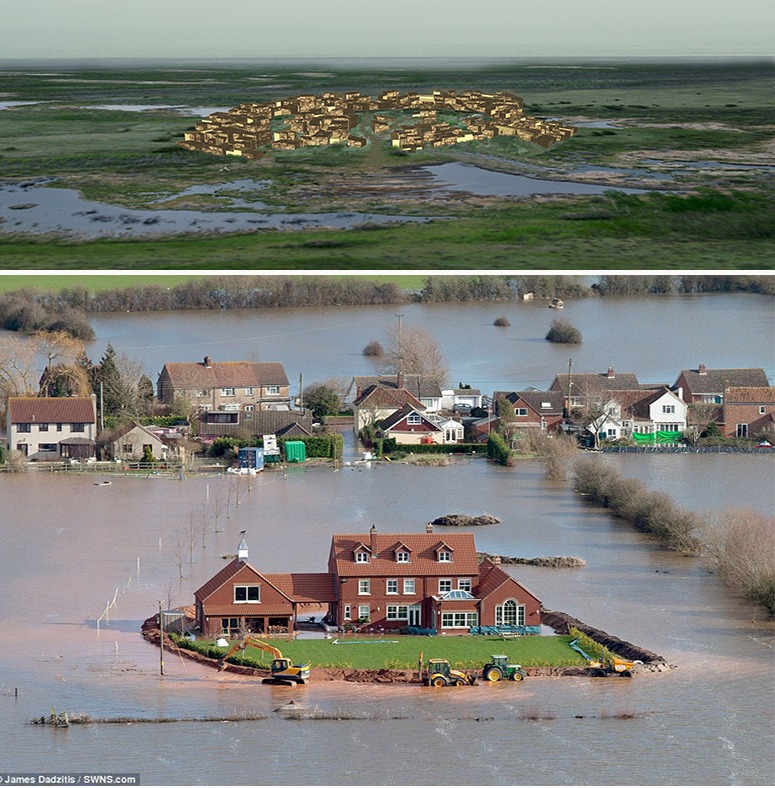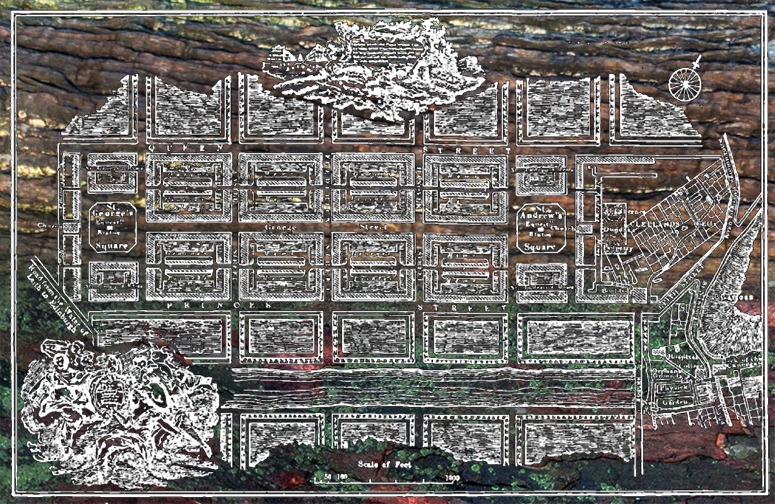 What goes around comes around. The top image is a reconstruction of one of the world’s oldest settlements, at Catal Huyuk in Turkey. Ancient Chinese cities were also protected from floods by high walls. The lower image (from yesterday’s Daily Mail) shows a builder’s determination to protect himself from the floods which have engulfed the Somerset Levels in 2014. See previous posts about the Waffle Method of protecting property from floods. This is what I would do if I lived in a flood-prone area: take my own flood-protection measures. I would of course have no objection to taxpayers building levees and digging channels to protect my property – but I would not trust their generosity. Here is another example of waffle-flood-protection in the flood plain of the Mississippi. Knowing that climate change is taking place, despite Prince Charles’ view of my stupidity, I would build the bund into the design of my garden rather than waiting until the flood waters crept up on my boundary. The bund would also protect the chickens-with-heads I would like to keep in my country garden. Since it would be protected against foxes I could let them enjoy a free-range lifestyle and roost in the trees in my country garden. One other thing: if I was a wealthy builder I would employ a garden designer for my private paradise in Somerset.
What goes around comes around. The top image is a reconstruction of one of the world’s oldest settlements, at Catal Huyuk in Turkey. Ancient Chinese cities were also protected from floods by high walls. The lower image (from yesterday’s Daily Mail) shows a builder’s determination to protect himself from the floods which have engulfed the Somerset Levels in 2014. See previous posts about the Waffle Method of protecting property from floods. This is what I would do if I lived in a flood-prone area: take my own flood-protection measures. I would of course have no objection to taxpayers building levees and digging channels to protect my property – but I would not trust their generosity. Here is another example of waffle-flood-protection in the flood plain of the Mississippi. Knowing that climate change is taking place, despite Prince Charles’ view of my stupidity, I would build the bund into the design of my garden rather than waiting until the flood waters crept up on my boundary. The bund would also protect the chickens-with-heads I would like to keep in my country garden. Since it would be protected against foxes I could let them enjoy a free-range lifestyle and roost in the trees in my country garden. One other thing: if I was a wealthy builder I would employ a garden designer for my private paradise in Somerset.
Category Archives: landscape planning
Freshkills Park, New York City – a Landscape Urbanism project by James Corner
With luck, I will have to change my mind when it is completed. But my present view of James Corner’s design for Freshkills Park is that it is a dull design for a dull place. It reminds me of many landscape reclamation projects completed in the north of England in the 1970s. ‘Before’ photographs, intended to shock the viewer, showed heaps of mining waste with scrubby vegetation. ‘DERELICTION’ we were told. ‘After’ photographs, were of several varieties: the mouse-under-the-carpet, the dog-under-the-carpet and the whale-under-the-carpet. The ‘carpet’ was an expensively created layer of greeny-yellow turf with a sparsity of dying trees. This is what the clients wanted, it has to be said, but the results were of very little ecological, visual or social value.
Another Freshkills puzzle is why it should be regarded as exemplifying a new approach to landscape architecture. I see Landscape Urbanism as postmodern and Freshkills as a good example of McHargian Ecological Design – which was a modernist approach. James Corner’s design for the High Line is excellent – so I remain optimistic that Fresh Kills will turn out well. I re-visited Richard Wilson’s wonderful 20:50 sump oil installation at the Saatchi Gallery recently and it made me wonder about Fresh Kills. As an access-route, why not cut a glass-sided trench though the heap of rubbish so that visitors can watch the decay progress? We could see leachate dripping onto old motherboards and the occasional pair of mating rats?. Then there could be a flare to burn off a tiny fraction of the methane.
Landscape Ecological Urbanism
Landscape Urbanism is a theory of urban planning arguing that the best way to organise cities is through the design of the city’s landscape, rather than the design of its buildings…. The first major event to do with ‘landscape urbanism’ was the Landscape Urbanism conference sponsored by the Graham Foundation in Chicago in April 1997. Speakers included Charles Waldheim, Mohsen Mostafavi, James Corner of James Corner/Field Operations, Alex Wall, and Adriaan Geuze of the firm West 8, among others.
The ecological urbanism project draws from ecology to inspire an urbanism that is more socially inclusive and sensitive to the environment, as well as less ideologically driven, than green urbanism or sustainable urbanism. In many ways, ecological urbanism is an evolution of, and a critique of, Landscape Urbanism arguing for a more holistic approach to the design and management of cities.
I welcome both initiatives as perhaps the most significant contributions to landscape design theory since the landscape architecture profession was launched in the mid-nineteenth century. But much the same group of people are involved in both initiatives and I am unpersuaded by the change of name. For the construct Ecological Urbanism to have a good chance of a long and happy life its two components would need careful definitions and accounts of their intension and extension.
LANDSCAPE Architecture has established itself as a design profession and uses the word landscape evaluatively – just as ‘a work of architecture’ differs from ‘a building’. ECOLOGICAL can be used evaluatively but is more often used to describe one of the natural sciences. The compound LANDSCAPE ECOLOGY uses both words descriptively. I would appreciate a justification for Ecological Urbanism’s claim, quoted above, to social inclusiveness. Mostafavi, in his introduction to a large book on the subject, provides no evidence of an interest in the social use of urban space – unless you include his final remark that ‘Guattari’s conception of an ethics of the ecological is an inherently political project with a commitment to countering the global dominance of capitalism’. I predict not many clients will brief ecological urbanists to overthrow global capitalism. So I suggest using the term Landscape (Ecological) Urbanism for a while – and then dropping the (Ecological) when people have recognized the ecological commitment. As Ian Thompson argued in 2000 (in his book on Ecology, Community and Delight: An Inquiry into Values in Landscape Architecture: Sources of Value in Landscape Architecture) the Vitruvian aims of landscape architecture already include Ecology. We just need to bang on about this important point.
See also Gardenvisit notes on Landscape and Ecological Urbanism
Note on the illustration: it shows James Craig’s famous plan for Edinburgh New Town superimposed on ‘the bark of a tree‘. The section of Craig’s drawing north of Princes Street was built and is a great success in its response to landform and views. The section south of Princes Street was not built and hardly could have been built. The land falls into a deep valley, occupied by a loch when the plan was drawn, and then rises steeply to Edinburgh Castle Rock – which is shown on the plan.
Another Stop Killing Cyclists event in London – to give a petition to the Mayor's advisor
Holding a box containing the signatures of 36,795 Londoners, including mine, Mayor Boris Johnson’s Cycling Advisor, Andrew Gilligan, states on this video that ‘I think we more or less agree about policy. The only disagreement is about timing’. WELL: if he was speaking to me then he agrees that cycling should receive 35% of London’s transport for at least the next decade, or until the percentage of journeys done by bike increases from 2% to 35%. At present cycling receives 2% of the TfL budget. So my comments are:
Whoopee!
Thank you very much Mr Gilligan!
London cycling die-in protest outside TfL offices on 29th November 2013
I have been hoping for a protest like this for years and was delighted to be there. Here is my next suggestion: Transport for London TfL should set a target for the percentage of journeys to be made by cycling and then (1) raise the percentage of the transport spent on cycling to that level eg 30% (2) ensure that the same percentage of TfL staff commute to the TfL office by bike.
Here is an excellent BBC news report on the demo in which Donnachadh McCarthy an organiser of the Stop Killing Cyclists Campaign, calls for 10% of the TfL budget to go on cycling (compared to 35% in Holland) and makes the excellent point that the Board of TfL is ‘big businessmen’ – with no representatives of pedestrians or cyclists. I see this as a key point. It is likely that TfL staff often cycle to work and support cycling. This is less likely to be the case for big businessmen.
Boris: please remember that you are the only politician I have voted for who has ever been elected: now is the time to come good: organise a London Cycling Summit and cram the board of TfL with die-hard cyclists. Please re-read the history of Lloyd George’s victory over the House of Lords. He asked “Should 500 men, ordinary men, chosen accidentally from among the unemployed, override the judgement – the deliberate judgement – of millions of people who are engaged in the industry which makes the wealth of the country?” The 1911 Parliament Act was passed only when King George V said he was willing to pack the House of Lords with Liberal peers to ensure the vote would swing their way. Bring on the cyclists.
The November 2013 event could be a great precursor for a full-scale event in The Mall in 2014, remembering Martin Luther King and the March on Washington of August 28, 1963. The 2014 event should be on the same weekend as another London cycling event eg the Prudential Ride on Sunday 10 August 2014. It is part of the Mayor of London’s annual festival of cycling.
London Sightseeing – a cruise on a River Thames Boat
How do Londoners and tourists regard the river Thames? This video was taken on a London City Cruise and you can hear the waterman’s commentary. I guess he loves the river but, like Joseph Conrad, sees it as being as much a place of darkness as a place of light – while also being a river of greatness, cruelty and folly, a place where kings are cruel and greedy, where most architects are fools and where the people remain cheerful, cynical and long-suffering. My view is that the river and its banks need enlightened planners, brilliant architects and imaginative landscape architects. That, and some money, could put London high in lists of the world’s top waterfront cities. The Mayor of London and the Greater London Authority (GLA) put their weight behind the 2012 Olympic Bid. They should now accept the challenge of getting near the top of these lists:
Great Waterfronts of the World
17 International Cities With Wonderful Waterfronts
World’s Top Waterfront Cities
Top 10 waterfront cities in the world
I do not know whether Joseph Conrad belonged to The Company of Watermen and Lightermen but he had many years experience as a seaman on the high seas, on the River Thames and in the West India Docks. I’m sure he would like to have London on these lists. He loved London, loved the Thames and lived in Tachbrook St, London SW1V 2NG.

